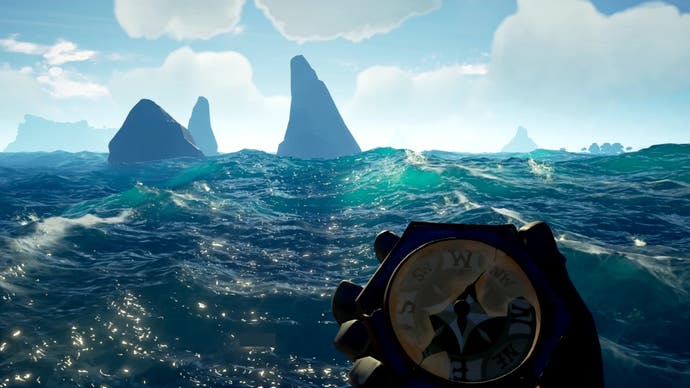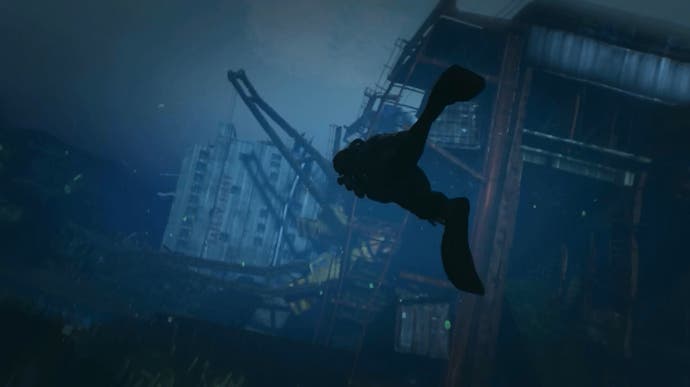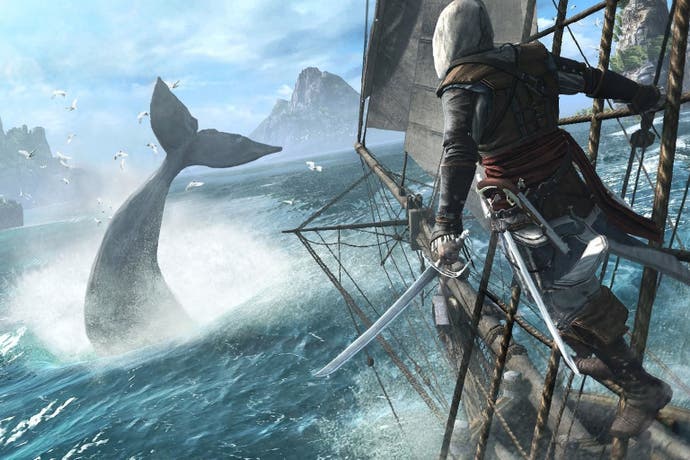Sea of meaning: how games have explored the ocean
Slope downwards to thy depths.
This piece contains spoilers for Rime.
"It's always ourselves we find in the sea" - e e cummings
You first notice it in the sand. The sun screes across the surface, glimmering in the silica and crushed quartz like lakes of blazing light. When you move, your body is a flying dream, each leap a shackle broken, drifting like a Chagall bride. Later on it grows more vivid: those blue caverns, shoals of fabric scraps darting back and forth, the wanderer's robes undulating like submerged cloth. The ocean is everywhere in Journey.
The game's art director, Matt Nava, seems transfixed by it. Despite its desert setting, these flourishes betray an Ishmaelian compulsion. To quote the mariner and mystic Herman Melville, Nava was "crazy to go to sea."
With Abzû, the first game from his own studio Giant Squid, that's exactly where he took us: a pure deep-sea diving game of terror and wonder. Thalassophobes feel dread and fascination at the endless blue, the churning compulsion to glimpse below as the waterline laps against the lens, despite the primal fear it induces - don't look down, lest what's down looks up, and opens its jaws. Is there any other medium as potent for probing this panic, putting a controller in our hands and dropping us in?
Certainly, in terms of physical exploration, games have empowered us while letting us stay dry on our sofas. They've also done a lot more than that. Like the books, poems, and films that precede them, games texture their seas with meaning. Below the waves, Nava's persistent motifs of lone drifters and civilisations lost carry on their current ideas of conservation, and restoration. But there is something else he found in the deep, something that speaks to the heart of the medium.

Playing Abzû means inhabiting a place of abyssal beauty. Galaxies of colourful fish burst across the blue, devoured whole by sleek predators, ignored by cruising giants. But its world is also an anti-place, an anti-design. Its ocean feels like the void space in which games are born: that vacuum from which all things are rendered. "It's not a lake. It's an ocean," says Alan Wake, aghast at the power and terrifying depth of his own imagination. Diving in Abzû's waters feel like being in this void; anything could manifest down here if it could only be imagined.
Is it any wonder that after years spent trawling the kerbstone shore of Rockstar's America, our volition dulled by straight roads and chartered wilds, that our imaginations fomented myths? Legends spread of Bigfoot prowling the pines, the Bermuda triangle lurking off the coast, haunted alleyways and ghost towns.
With GTA 5, the submersible took us down into the void, to what felt like a shared marine subconscious. Laid out on the Los Santos sea floor were the bones of a leviathan, bursting from the earth like a clawing hand fossilised in its last drowning moments. At first players thought it the remains of a sea monster. All it was was a long dead whale, but it didn't matter; it was Rockstar saying to its most intrepid fans, "We know where you dream, don't give up the hunt, anything is possible here."
That's often what the ocean is in games: a hunting ground. It's a glorious Ahabian conceit, the idea that the water is there to be conquered, and games are the perfect medium to express it - the player the centre of their own world, one to be mapped and completed. Whether it be the blue expanse of Assassin's Creed Black Flag, to be de-fogged and checked off, or the picaresque playground of Sea of Thieves, host to a grog-sodden voyage of friendship and plunder.

To look at the ocean with that wonderful naivety is to explore it in new ways. The joy of The Wind Waker's sea, for instance, is the way it's so clearly crafted. Its flat-coloured azure looks as if it's been filled with a single click, the little white-capped waves giving way to seafoam like the lacing in a beer glass. For all its kingdom-smothering depth it looks a shallow canvas, a giant wafting duvet fit for childlike adventure.
Yet with the same ecstatic colour palette, Rime reveals the Janus-faced nature of the sea: giver and taker of life. It's where we come from, the closest thing to god we can touch with our hands, but it can so easily destroy us. In Rime, just as in Journey before it, the ocean is everywhere in coded flourishes. The boy's helical descent down keyhole-shaped halls feel as if he's caught in a whirlpool, the figures of father and son circling each other, unclear who is pursuing whom. The sea is a gulf between them, a literal partition between the living and the dead.
Between the dolorous and the joyous is awe, and isolation-something Subnautica recently captured with its blend of exploration and survival. Having to survive in Subnautica's alien ocean is a constant reminder that we are somewhere we shouldn't be, yet we are awash with ways to study, collect, and use. It's a contradiction that speaks to what games are: worlds that we have no place in, that we are spirited to with technology and equipment; worlds where there is no oxygen, that we can see on the other side of the glass; worlds we peer into like a rippling reflection.
The reason we keep coming back to the sea in games is the same reason that we keep coming back to it in every other art form. Just as Melville knew, when he felt a "damp, drizzly November" in his soul, that it was "high time to get to sea," we are tidally pulled back there. As much as we might romanticise what secrets are buried in that blue vault, it wouldn't matter what we found. The reason we return is to search for the unknown in ourselves.
